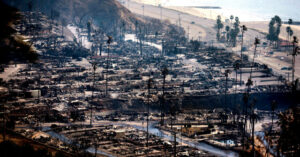Toxic environment under war-like conditions. This is how Professor Vassilis Christopoulos from the University of Southern California describes everything California is experiencing due to the wildfires.
The region is being swept by massive wildfires that have consumed thousands of acres of land, homes, and facilities worth billions of dollars while leaving 10 dead so far. At the same time, hundreds of prisoners have been thrown into the battle with the flames, according to international media.

Specifically, speaking to ERT on Friday morning, Christopoulos described dramatically the conditions experienced by the residents of the American metropolis and the surrounding areas. “We can’t move outside. The water is problematic and the environment is toxic,” he said from Pasadena where he spoke. Residents, he noted, are forced to use only bottled water, as contamination of the water supply system makes it impossible to use the water even for brushing teeth or cooking.
He further pointed out that air toxicity has necessitated the use of masks by residents, while authorities warn of serious public health risks.
“The fire right now is not even 1 percent controlled,” the professor stressed, explaining that the fire is mostly burning in the mountains and has not yet entered the city where he lives. Nevertheless, the speed at which it is spreading is a matter of grave concern.“The strong winds, reaching 150-200 kilometers per hour, have aggravated the situation, causing biblical destruction,” he said.
According to Christopoulos, the psychology of residents has collapsed, with many comparing the conditions to those of a war: “The situation is reminiscent of war conditions. California has experience with fires, but this is unprecedented and uncontrollable.”
In the battle with the flames and the prisoners
The California Department of Corrections has confirmed to the BBC that nearly 800 prisoners have joined CalFire to help control the spread of the fires as part of a volunteer program.
CalFire has now deployed around 4,700 of its first responders, so this is a surprisingly significant number of prisoners supporting the response.
The California Department of Corrections and Rehabilitation operates statewide firefighter training camps for prison inmates, who support the response to disasters by authorities.
More than 1,800 incarcerated volunteer firefighters are housed at these camps, officials said. They typically earn little to no money, according to rights groups.
Fire fronts are seen in Los Angeles
Authorities and residents are battling to cope with the unprecedented conditions. However, the devastation already wrought makes recovery particularly difficult, and the climate crisis continues to pose new challenges for California and the planet.
At least 10 people have died in the fires raging around Los Angeles, the county coroner’s office said late Thursday night (local time).
“The coroner’s office has been notified of 10 deaths associated with the fires,” it noted in a statement, adding that the process of identifying the victims and notifying their families is ongoing.
Unstoppable water and retardant foam spraying
Meanwhile, in the smoke-blackened skies of Los Angeles, dozens of firefighting aircraft and helicopters were non-stop dropping water or retardant foam yesterday to contain the flames ravaging sectors of the Californian metropolis.

Authorities have urged people to conserve water as reservoirs are being emptied and firefighters are now turning to pools and fountains to stock up.
“I’ve never seen so many at the same time,” Albert Azuz, a helicopter pilot aboard which journalists flew over the second-largest US city facing the “most destructive fires in the state’s history”, as outgoing US President Joe Biden put it, assured Agence France-Presse in the past 24 hours.
Working for a private airline since 2016, Albert Azuz has seen many fires. He particularly remembers the ones that swept through the bathing town of Malibu, west of Los Angeles, six years ago.
“It was crazy,” he says, with the smoke-filled ether of the big city as a backdrop.
Reporters in the helicopter could see at least six fronts. The horizon was covered by huge columns of smoke rising from mountains and hills around the city.
In the sky, they could closely observe the endless ballet of Canadair and helicopters near Calabasas, an expensive area full of multi-millionaire vacation homes west of Los Angeles, where a fire broke out last night.
Six helicopters operated at low altitudes in this zone to drop water on the flames.
At higher altitudes, small aircraft played the role of guides for huge aircraft with tanks full of retardant foam, making drops to stop the spread of fires.
Several aircraft, including modified Boeing Chinook helicopters capable of dropping up to 10,000 litres of water, were sent from Canada.
However, when the first outbreaks of fire broke out in Los Angeles on Tuesday, no aircraft were able to operate at all: gusty winds were blowing with gusts of up to 160 kilometres per hour.
Now, firefighting aircraft and helicopters can act and are an essential weapon in the battle with the flames. Yesterday, helicopters made hundreds of drops.
After sunset, those aircraft with night flight capability continued their departures, at least as long as the winds allowed.
However, Super Scooter, Canader’s amphibious firefighting aircraft, capable of dropping hundreds of liters of water at a time, was grounded due to a collision with a drone.
The accident did not cause any injuries – the firefighting aircraft has a hole in its wing and will need repairs that are unclear how much it will take, according to US media reports – but the federal Federal Aviation Administration (FAA) said it has begun an investigation and warned that anyone sending unmanned aerial vehicles into areas where firefighting operations are taking place faces up to a year in prison.
Ask me anything
Explore related questions





